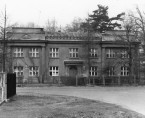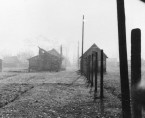Harmense
Two sub-camps located in the village of Harmęże (German: Harmense), about 2 km from Birkenau, whose Polish residents had been expelled by the Germans. The first of them was founded in December 1941 when about 50 Polish prisoners were billeted on the second floor of a manor house whose owner had been expelled. They occupied rooms separated from the rest of the house by a barred, padlocked door. They were employed raising poultry and rabbits, and maintaining the fishponds. In June 1942, these male prisoners were moved to two buildings in the village, and more than 30 women prisoners took over their former lodgings in the manor house. At the end of the summer of 1943, the male prisoners were incarcerated in the nearby Auschwitz sub-camp named Budy, thus liquidating the men’s sub-camp in Harmense. At this point the women prisoners replaced the men at work—cleaning out poultry coops, preparing chickenfeed for about two thousand hens, working in the incubators, looking after one thousand ducks, five hundred turkeys, and three hundred geese and, above all, caring for three thousand angora rabbits raised for their wool. Conditions and food in Harmense were better than in Birkenau and it was easier for the prisoners to “organize” (Lagersprache) additional food. The directors of the camp were SS-Unterscharführer Bernhard Glaue, followed by SS-Rottenführer Xaver Eidenchinkt. In January 1945, the women were evacuated to Wodzisław Śląski and from there by train to other camps in the Reich.

